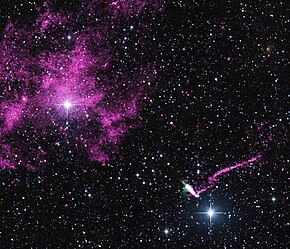

| Nebula | |
|---|---|

Composite image of IGR J11014-6103 and MSH 11-61A that contains data from NASA's Chandra X-ray Observatory (purple), radio data from the Australia Compact Telescope Array (green), and optical data from the 2MASS survey (red, green, and blue)
| |
| Observation data | |
| Constellation | Carina |
| Notable features | Possible undiscovered neutron star and two bright spots |
| See also: Lists of nebulae | |
G290.1-0.8 (also known as MSH 11-61A[1]) is a supernova remnant in the constellation Carina.[2] It is located in the Galactic plane of the galaxy in the Carina arm.[3]
The supernova remnant has two bright spots opposite symmetric to each other on a symmetry axis running towards north west-south east direction. Theses bright spots are not homogeneous to the rest of the supernova remnant and had not reached ionization equilibrium yet.
This suggests that there might be a neutron star that has not been discovered yet. The rest of the supernova remnant originated from a high mass star that went supernova with a possible strong bipolar wind.
|
| |||||||||||
|---|---|---|---|---|---|---|---|---|---|---|---|
| |||||||||||
| Stars |
| ||||||||||
| |||||||||||
| Star clusters |
| ||||||||||
| Nebulae |
| ||||||||||
| Galaxies |
| ||||||||||
| |||||||||||
| |||||||||||
This nebula-related article is a stub. You can help Wikipedia by expanding it. |